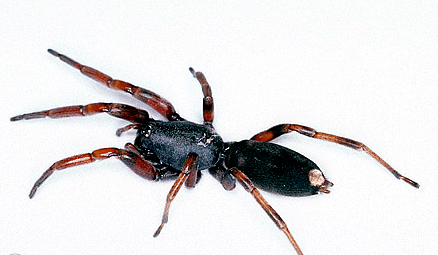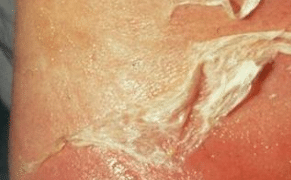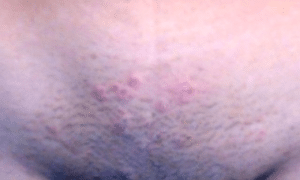What are the symptoms of a white tail spider bite? Get insights on the stages of healing, pictures and best treatment.
The white tailed spider is commonly found in homes throughout Australia. It tends to hide in bedding, or within cloths left on the floor or unsafely kept. The scientific name for this kind of specie is called Lampona cylindrata. They can be found in other continents too though in rare cases. The white tail spider bite can be so painful since it produces a certain venom when it bites.
White Tail Spider Bite
When you have had a white tailed spider bite, you may see welts, blistering or local ulcers which have been reported as symptoms together known medically as necrotizing arachnidism, although recent research suggests that the white spider bite is probably not linked to this condition.
In most cases the bite from a white tailed spider only causes a mild reaction, including itching and skin discoloration, which usually resolves after a few weeks.
There are no specific first aid treatments for a white tail spider bite, except the use of icepacks to help relieve the swelling. You should not use antibiotics. Always see your doctor if any spider bite does not clear up.
You may as well seek advice from your local council or a professional pest control operator on how to eliminate the white tailed spider from your home.
White Tail Spider Bite Pictures
White tail are active hunters, preying upon other type of spiders, and may be found roaming inside houses, especially in warmer weather. White tail usually is white and the end part of the abdomen as you can see in the pictures.
It has been implicated in cases of ulceration or necrosis following spider bites. The incidence of ulceration following white tail spider bite is not known. The majority of cases appear not to develop ongoing ulceration, although blisters and redness are common.
Characteristics of a white tailed spider
- Having a cylindrical body
- Being from 1 cm to 2 cm in length
- Being dirty grey to brown color
- Having glossy legs
- A characteristic light colored grey or white spot at the tail
- That two similar spots near the front of the body may also be present.
Hiding spots for white tailed spiders
These kind of spiders are found in homes throughout Australia. They tend to be more active during summer. They may like to hide in places like;
- Bedding
- Towels or cloths left on the floor
- Nooks and crannies
- Beneath mulch, leaves and rocks
- Beneath tree bark.
Signs of a white tailed spider bite
Bites can occur anywhere on the body, but most often on arms and legs. The symptoms of a white tailed spider bite can include:
- Localized irritation, such as a stinging or burning sensation
- A small lump
- Localized itchiness
- Swelling
- Discoloration of the skin
- Ulceration of the bite in some cases
- Nausea and vomiting in some critical cases.
First aid for a white tail spider bite
Always try to keep the spider for identification purposes if you have been bitten. First aid suggestions to treat a white tailed spider bite may involve:
- Applying an ice pack to help relieve swelling
- See your doctor if the skin starts to blister or form ulcers.
What is necrotizing arachnidism?
This is a type of skin inflammation and ulceration that is caused by the bite of some spiders. Occasionally, the reaction is so severe that the person loses large amounts of skin and needs extensive skin grafts.
The white tailed spider and the black house spider, also found in Australia, have both been linked to necrotizing arachnidism. Usually, a study in the medical journal of Australia in 2003 examined 130 confirmed cases of white tail spider bite and found that none had caused necrotizing arachnidism.
The study found most bites happened indoors, in warmer months and at night. In two third of the cases, the spider was caught in bedclothes towels or clothing. Most bites were painful, with some redness and itching. Nearly half the cases had a persistent painful red lesion, but none of the lesions were found to be necrotic
There is no confirmed cause of necrotizing arachnidism. It is unclear why most people who are bitten have only mild reactions, while a very tiny minority suffers from skin ulceration. Researchers have different opinions, but the current theories on the causes of necrotizing arachnidism include:
- Mistaken identity – some researchers believe that white tail spider bites are not capable of causing skin ulceration and suggests that other spiders or other factors are to blame.
- Misdiagnosis– in rare cases, a diagnosis of necrotizing arachnidism has later been found to be another condition
- Pre-existing medical conditions – various immune system disorders or problems with the circulatory may predispose a person to necrotizing arachnidism.
White Tail Spider Bite Symptoms
This white tail spider bite is among the most feared kinds of spider bites. Other two spider which are even more dangerous include black widow spider bite and brown recluse spider bites.
In order to determine whether the bite you experienced is from white tail spider, it is essential to immediately see which insect bite you.
If it is a spider then determine how it looks. Its appearance will help you determine which spider bite you are suffering from. In order to do this you need to understand characteristics of a white tail spider.
Many humans have suffered from white tail spider bite. The bite can cause a number of symptoms such as localized pain and swelling, occurrence of a reddened patch, irritation, and itching. Sometimes, additional symptoms such as headaches, malaise, nausea and vomiting may also be noticed.
In the past, it was a widespread belief that white tailed spider bites resulted in development of ulcers and necrosis, that is, gradual deterioration of the skin. The researches that were carried later however confirmed this belief not to be true.
Lampona murina and lampona cylindrata, the two most common types of white tailed spiders are almost similar in appearance. As compared to lampona murina, lampona cylindrata is slightly larger in size. The male species of the latter can reach a full body length of about 12mm, while females can grow up to 18mm. their legs have a diametrical span of approximately 28mm.
Both the types of this spider species Lampona murina and lampona cylindrata have to be investigated under a microscope to get a clear differentiation. Both of them are quite slim and feature an elongated body that is either gray or dark reddish in color.
Two light white marks can also be observed on their abdomens. Although, the primary characteristic is the prominent white mark present at the tip, just above the web –spinning gland.
Symptoms include:
Some of the signs and symptoms of white tailed bites are listed as follows:
- White tailed spider bites are often noticed on the legs and arms
- There may be localized redness that is accompanied by inflammation, pain, and itchiness of the affected area. The pain is however short-lived and may go away after a short period of time.
- On occasions the location of the white tailed spider bite may elicit a reddish bump. Incessant scratching can cause the skin to tear up and result in an open wound which is then susceptible to secondary infections from bacteria.
- The bite also can be sometimes accompanied by other symptoms like vomiting, nausea, mild illness, and headaches. These symptoms also vanish without treatment.
- The venom of white tailed spiders is not potent. Hence, unlike the widespread myth, white tailed spider bites do not lead to development of ulcers or extensive skin damage.
White Tail Spider Identification
White tail spider are slender looking, 1-2 cm in length, typically grayish or sometimes brownish in color with orange to brown bundled lengs and usually with a distinct cream – white marking on the tip of the tail. Males and juveniles may have additional white spots on either side of the abdomen.
The leg of a fully grown specimen about the size of a fifty – cent coin. The two species present in New Zealand cannot easily be distinguished from one another without close examination under a microscope.
White tail spider are often medium in size. They are mostly found in southern region of Australia. Nevertheless these spiders may be present anywhere. In United States there are a few incidences of white tail spider bite recorded in medical industry.
These type of spiders are known to be white tail because they have a whitish spot at the tip of their rear end of the abdomen. These are vagabond spiders which makes them different from other conventional spiders.
White tail spiders do not spin their webs, but they wait for their pray to get entrapped. In fact white tail spiders hunt for prey by wondering.
These spiders eat insects but they also prefer other regular spiders as their victim. These spiders also have venom which makes it easy for them to hunt down their prey. There are considerable reports of white tail spider bite as the attack human and cause serious symptoms.
This type of spider is known to be active in hot and humid climates. You may find such spiders not only in attics but also in cloths, beddings and many more other places.
The body of white tail spider is cylindrical. The spider is also medium sized measuring around 1 to 2 cm. these spiders may be seen in different colors such as grey, brown etc., and may have glossy legs.
The identification that makes these spiders distinctly recognizable is a white spot appearing in the rear end of the abdomen of the spider. In some cases there may be two white spots appearing on the front of the body.
The venom of the white tail spider bite
This kind of venom produced by a white spider is usually sophisticated mixture of different substances. It usually has one or more than one main components which can lead to clinical reactions in human bodies.
Far studies carried out on white tail spider venom indicated presence of potentially harmful substances. Usually, there were no substance that could permanent or significant skin damages.
White Tail Spider Bite Stages
The majority of spiders cannot harm anyone. They are unpleasant to look at and their webs can cause a mess in one’s environment. From the tarantula to common house spider, we can give you more information about these creatures to help you get them over your day to day life activities and over your fears.
Life cycle
Tufts of specialized scopulate hairs on the ends of their legs allow them to walk easily on smooth or sloping surfaces. They make temporary silk retreats and spin disc- shaped egg sacs, each containing up to 90 eggs.
Habitat
White tail spider are vagrant hunters that live beneath bark and rocks, in leaf litter, logs and detritus in bush gardens and houses.
Stages
The female white tail spider lays her eggs in late summer to autumn. The eggs are encased in a fluffy cocoon and attached to foliage.
During autumn, the spider lings disperse by ballooning (floating on the breeze using small silk strands as balloons) and build their own tiny orb webs among vegetation.
The lifespan is about twelve months, they mature in summer, mate, lay their eggs, and die in the late summer- autumn.
White Tail Spider Bite Treatment
The white tailed spiders as stated earlier are species which are found in the eastern and southern parts of Australia. They are usually not too large or too small. They are referred to as white tailed spiders due to the presence of a whitish spot in the last section of their abdomen. Lampona murina and lampona cylindrata are the two most common species of white tailed spiders.
White tailed spider bites do not result in any health complications. The symptoms may be treated in the following ways:
- The site affected by the spider has to be thoroughly washed with soap and water.
- Local pain may persist for many hours, while minor swelling may last from a day or two. You can use non- prescription pain killers to alleviate the pain. Swelling and inflammation may be eased via use of topical corticosteroids. The pain and swelling can also be reduced by application of ice compresses after every 2 to 3 hours.
- Itchiness and stinging sensations can be decreased by using anti- sting ointments. You may also apply an ice cube or a paste made from cold water and baking soda to the affected area. Your doctor may recommend antihistamines to find relief from itching of the white tail spider bite.
- A severe allergic reaction to spider bites called anaphylaxis is a life- threatening situation and requires emergency care. It can be identified by varied symptoms such as wheezing and or throat, hoarse voice, rapid rash formation, fainting or dizziness, swallowing difficulties, persisted coughs or sneezing, high fever, and pale skin.
It is a very good option to try to catch the spider and take it to the doctor who will examine it to know which kind of venom it may be carrying, hence establish the best medications required.
However, bites from poisonous spiders like black widow or brown recluse spiders that generally live in undisturbed areas are dangerous. In such cases, it is recommended to get medical help, especially if you experience symptoms like severe swelling, intense pain and stiffness, muscle spasms, fever and chills, abdominal pain, vomiting, difficulty breathing and lightheadedness.
Home Remedies for White Tail Spider Bite

white tail spider picture
Ice pack when bitten by the spider, the first thing you need to do is clean the wound with mild soap and water. Then, apply an ice pack on the affected area. The cold temperature will help numb the nerve endings, soothe the itching sensation and reduce the swelling and inflammation.
Baking soda
This is an effective treatment for spider bites. It is an alkaline substance that can help draw out the venom, which will help reduce the pain, itching and inflammation. You can make a sap out of it by mixing with little water, then smear the sap on the wound and allow it to stay for some time before washing it off.
Salt
This is another easy remedy due to its antiseptic and anti- inflammatory properties, it can effectively draw the venom out of the wound of a white tail sider bite to promote quick healing. In addition, it reduces inflammation and redness.
Wash the affected area with Look warm water and smear some table salt on the wound with a wet cloth
Activated charcoal
Activated charcoal is another treatment option. It has an innate absorption property that helps draw out and remove toxic substances from the body. After the toxic substance is out of the body, inflammation and tenderness reduce automatically.
Make a paste of activated charcoal using a little water, apply it on the affected area after cleaning over it.
Potatoes
Another easy and effective method is to use a starchy potato. It can bring down the itching and inflammation, largely due to its anti- irritating and soothing properties. In addition, it keeps the affected area moisturized to encourage quick healing.
Clean the affected area with rubbing alcohol, then put a potato poultice on it. Leave it until the potato begins to dry.
Aspirin
You can as well relieve minor symptoms of spider bites using aspirin. It can neutralize the venom to promote quick recovery. In addition, it has strong anti- inflammatory properties that can effectively control swelling and inflammation.
Soak some aspirin tablets in little water and apply the paste on the affected area.
Turmeric
It is a natural pain killer containing an anti- inflammatory, antiseptic and antioxidant properties. It can promote recovery by reducing pain, swelling and inflammation.
Mix a teaspoon of turmeric powder with olive oil and apply the paste on the wound. Let it stay for about 10 minutes before washing it away.
Lemon juice
You can use the lemon juice to keep the itching, swelling and inflammation at bay. Being a natural astringent, it also helps quickly dry out skin rashes caused by white tail spider bite as well as prevent infection.
Aloe Vera
You can also use the gel of aloe Vera for treating spider bites. This gel has natural antiseptic as well as anti- inflammatory and soothing properties that can help reduce pain, swelling, and itching. It can even aid in faster healing by keeping the affected area moisturized.
Peppermint
This herb exhibits anti- inflammatory and analgesic properties that help relieve pain, swelling and inflammation. It even soothes and calms itchiness caused by spider bites.
Rub freshly extracted peppermint juice on the affected area. Leave it on for 15 to 20 minutes before rinsing it off with cool water.
Note: always do a spot test before applying peppermint oil directly on the skin.
Additional tips
- Monitor the bite for a couple of days to keep a check on how well the symptoms are healing
- Try to memorize the appearance of the spider that has bitten you. This will help in the treatment plan
- To prevent spider bites, wear a long- sleeve shirt pants, a hat, gloves and boots when handling stored boxes of firewood.
- Be extra careful when cleaning out sheds, garages, basements, attics and crawl spaces.
- Inspect and shake out gardening tools that are not in use for a while.
- Keep spiders out of the house by installing tight- fittings screens on windows and doors.
- Discard old boxes, clothing and other unwanted items from the storage areas.
- Remove piles of rocks from your garden area.
Further references
- Treatment of spider bites: top10homeremedies.com/home-remedies/home-remedies-for-spider-bites.html/3
- Australian spider identification and spider bite treatment: https://www.australiawidefirstaid.com.au/australian-spider-bite-identification-treatment/
- How to notice a white tailed spider: kiwicare.co.nz/help/problem/?sid=white-tail-spider
- Different types of spiders and their life cycles: www.rentokil.com.au/spiders/species/










1 Comment